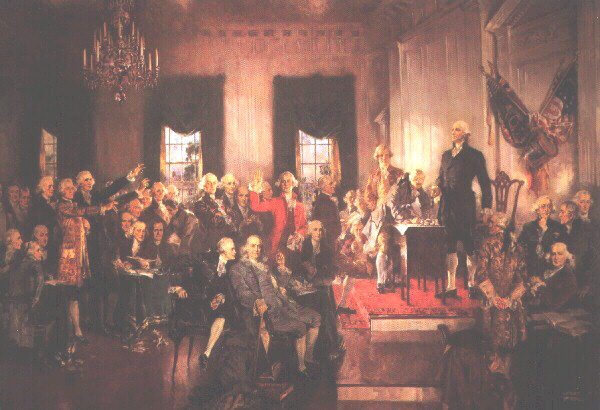FRtR > Outlines > The American Government > Explaining the Constitution: The Federalist Papers > ....But what is Government.....
An Outline of American Government
Explaining the Constitution: The Federalist Papers
....But what is Government.....
*** Index * Next Chapter > ***
"BUT WHAT IS GOVERNMENT ITSELF BUT THE GREATEST OF ALL
REFLECTIONS ON HUMAN NATURE?"
JAMES MADISON, The Federalist
Papers
THE FEDERALIST: A COLLECTION OF ESSAYS, WRITTEN IN
FAVOR OF THE
NEW CONSTITUTION, AS AGREED UPON BY THE FEDERAL CONVENTION,
SEPTEMBER 17, 1787.
Written by Alexander Hamilton, John Jay
and
James Madison.
Thomas Jefferson called
The
Federalist
Papers "the best
commentary on the principles of government ... ever written."
For the 19th-century English philosopher, John Stuart Mill,
The
Federalist, (as the collection of 85 short essays was usually
titled) was "the most instructive treatise we possess on federal
government." The astute French political commentator, Alexis de
Tocqueville, thought it "an excellent book, which ought to be
familiar to the statesmen of all countries." In the 20th
century, historians, jurists and political scientists have
generally agreed that The Federalist is the most important
work
of political philosophy and pragmatic government ever written in
the United States. It has been compared to Plato's
Republic,
Aristotle's Politics and Hobbes' Leviathan. And it
has been
consulted by the leaders of many new nations in Latin America,
Asia and Africa as they were preparing their own constitutions.
 The delegates who signed the drafted
Constitution in Philadelphia
on September 16, 1787, stipulated that it would take effect only
after approval by ratifying conventions in nine of 13 states.
Although not stipulated, a negative vote by either of two key
states -- New York or Virginia -- could destroy the whole
enterprise because of their size and power.
Both New York and
Virginia delegates were sharply divided in their opinions of the
Constitution. And New York governor George Clinton had already
made clear his opposition.
The delegates who signed the drafted
Constitution in Philadelphia
on September 16, 1787, stipulated that it would take effect only
after approval by ratifying conventions in nine of 13 states.
Although not stipulated, a negative vote by either of two key
states -- New York or Virginia -- could destroy the whole
enterprise because of their size and power.
Both New York and
Virginia delegates were sharply divided in their opinions of the
Constitution. And New York governor George Clinton had already
made clear his opposition.
One would imagine that a work so highly praised and so
influential as The Federalist Papers was the ripe fruit of
a long
lifetime's experience in scholarship and government. In fact, it
was largely the product of two young men: Alexander Hamilton of
New York, age 32, and James Madison of Virginia, age 36, who
wrote in great haste -- sometimes as many as four essays in a
single week. An older scholar, John Jay, later named as first
chief justice of the Supreme Court, contributed five of the
letters.
Hamilton, who had been an aide to Washington during the
Revolution, asked Madison and Jay to join him in this crucial
project. Their purpose was to persuade the New York convention
to ratify the just-drafted Constitution. They would separately
write a series of letters to New York newspapers, under the
shared pseudonym, "Publius." In the letters they would explain
and defend the Constitution.
Hamilton initiated the venture, outlined the sequence of topics
to be discussed, and vigorously addressed most of them in 51 of
the letters. But Madison's 29 letters have proved to be the most
memorable in their combination of frankness, balance and
reasoning power. It is not clear whether The Federalist
Papers,
written between October 1787 and May 1788, had a decisive effect
on New York's grudging ratification of the Constitution. But
there can be no doubt that they became, and remain, the most
authoritative commentary on that document.
*** Index * Next Chapter > ***
 The delegates who signed the drafted
Constitution in Philadelphia
on September 16, 1787, stipulated that it would take effect only
after approval by ratifying conventions in nine of 13 states.
Although not stipulated, a negative vote by either of two key
states -- New York or Virginia -- could destroy the whole
enterprise because of their size and power.
Both New York and
Virginia delegates were sharply divided in their opinions of the
Constitution. And New York governor George Clinton had already
made clear his opposition.
The delegates who signed the drafted
Constitution in Philadelphia
on September 16, 1787, stipulated that it would take effect only
after approval by ratifying conventions in nine of 13 states.
Although not stipulated, a negative vote by either of two key
states -- New York or Virginia -- could destroy the whole
enterprise because of their size and power.
Both New York and
Virginia delegates were sharply divided in their opinions of the
Constitution. And New York governor George Clinton had already
made clear his opposition.